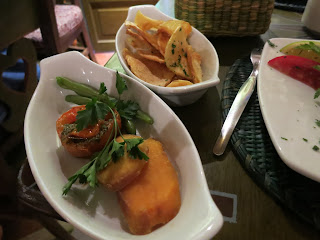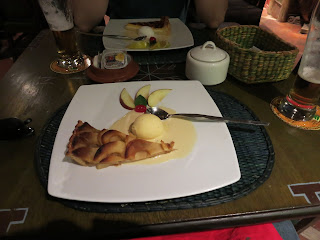Peru's current president promised to establish facilities to clean the water quality of the Lake Titicaca when he was elected. However, he hasn't accomplished anything despite the end of his term, which is coming soon. Therefore, the residents of Puno decided to protest in order to insist that the current president keep his promise before he completes his term.
Anyway, I walked about 30 min to the ferry dock, which I didn't mind at all. But that was much longer than what the guide mentioned initially...
The first ferry stop was at one of the Uros islands. In fact, the Uros islands are man-made floating islands made with reeds that grow in the lake. The picture below is of the reeds and the inside white part can be eaten. It was very spongy and had no flavor. I guess it's just fibers... A boy on the island was eating reeds like a snack, though.
After visiting the Uros islands, the tour group moved to Taquile island. The lunch was served by the residents. Quinoa soup and trucha (trout) that was caught in Lake Titicaca. Unfortunately, the trout had the muddiness that fresh water fish usually brings. But it seemed very fresh and nicely cooked.
When I finished the tour, the guide told me that the protests will continue to tomorrow. The plan for tomorrow had originally been a short tour in the morning on the way to the nearby airport in Juliaca. However, because of the protest, the streets will be blocked and we can't get out of Puno. So, we need to leave Puno very early before the protesters wake up, like 3:00 am. Well, it's better than being stuck in Puno because I already made plans for tomorrow in Lima...
Because the protesters were blocking the street around the city, the city center was pretty quiet. I was worried that there wouldn't be any restaurants open tonight. Luckily, that wasn't the case. I didn't expect any non-pizza-related restaurants in Puno, but found one French-Peruvian restaurant, which is La Table del'Inka. The restaurant was located in very shady area. Because the city center is much quieter and it was getting darker, I wasn't sure if I should even try to go there... But I'm so glad I did!
One of the two starter is Trucha (Trout) cebiche. I've tried trucha cebiche a couple of times since I came to the mountain area (because they don't have access to salt water fishes). But I decided to give another try because this is French-Peruvian restaurant. It was more like trout tartar and a bit sweet side but the it was full of flavor. I can totally see this dish as French-Peruvian fusion dish.
Another appetizer is quinoa tabouleh with anticucho (skewed beef heart). This was very well seasoned with nice acidity. The anticucho was a bit too sweet by itself but balanced out with the tabouleh.
This is the French interpretation of the lomo saltado. Beef fillet with bourguoignon sauce along with potato gratin. It's more French than Peruvian. In fact, this is totally French. Nonetheless, it was a decent dish.
Another entree is Quinoto, which is a quinoa risotto. The risotto was shaped into a burger. I believe this is a vegetarian dish but it was full of flavors. Very nice presentation also.
Once I get back to the hotel, the tour agent called me to say that we are leaving 4:00am (instead of 3:00am). That's great but hope I can get to the airport safely...







































